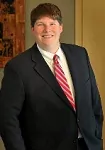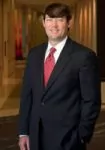- within Insurance topic(s)
- with readers working within the Insurance industries
"Anybody else have something to say?"
- Ted Lasso, S3 Ep 12
Robert Burgett is a good neighbor.1 He keeps his yard tidy. And in the summer of 2010, in the rolling hills of eastern Kentucky near the town of Belfry, Burgett tried to do just that. Earlier that year, he purchased a new Bronco riding lawnmower from the big box home improvement store. And on this fateful summer day, Burgett tried to be neighborly. But riding lawnmowers are not meant for hilly terrain like Burgett's front lawn. When the Bronco tipped "back, up and to the side," Burgett was thrown from the driver's seat. For Burgett, the nightmare was only beginning. The Bronco was not finished with Robert Burgett just yet.
The pressure "kill switch" in the mower's seat should have activated when Burgett fell off the mower. According to Burgett, it didn't. Instead, the mindless machine righted itself, executed a 180-degree turn, and charged downhill toward the dazed Burgett. The mower's blades caught Burgett's foot, nearly amputating a toe in his front yard. Any respite was only temporary; as part of his medical treatment, Burgett ultimately lost two toes. There were no other witnesses, no one who could contest Burgett's Terminator-like description of the lawnmower's relentless bloodlust. Or were there?
"You'll know it when you see it."
- Ted Lasso, S2 Ep 6
Someone else was at the scene that day in 2010; or rather, something else. And whether it's a lawnmower, a wheelchair, a surgical handpiece, or any other product at the center of a personal injury products liability suit, that allegedly defective product often contains information critical to the claims and defenses of the parties. In addition to being the single most important piece of evidence in such a case, the product can often supply key "testimony" to the details of the accident.
Enter Fed. R. Civ. P. 34. In day-to-day civil litigation, Rule 34 defines and governs the production of documents, the lifeblood of discovery. But the rule also contains a lesser-used provision for a party to "inspect, copy, test, or sample ... any designated tangible thing." Rule 34(a)(1)(B). Such requests are not limitless; the rule demands reasonableness as to descriptions of the "thing" to be inspected and as to time, place and manner of inspection. Rule 34(b)(1)(A) and (B). In Robert Burgett's case, the parties inspected the Bronco lawnmower twice in 2012. Ultimately, the lawnmower's good working condition at the 2012 inspections had "something to say" to rebut Robert Burgett's allegations. 2
The specific parameters of a Rule 34 product inspection are as follows:
- Rule 34(a) – Within the scope of Rule 26(b) – Fed. R. Civ. P. 26(b)(1) is the "go to" rule for the scope of permissible discovery, with its familiar refrain: "Parties may obtain discovery regarding any nonprivileged matter that is relevant to any party's claim or defense ... Information within this scope of discovery need not be admissible to be discoverable." (Emphases added). The rule also includes important disclaimers, including "[u]nless otherwise limited by court order," "proportional to the needs of the case," and "whether the burden or expense of the proposed discovery outweighs its likely benefit." Typically, in a products liability case, permissible scope of discovery for a product inspection is a low bar to clear.
- Rule 34(a)(1)(B) – Any designated tangible thing – Having met the discovery scope requirement, Rule 34 next allows the requesting party (or representative) to inspect any designated tangible thing within the responding party's possession, custody, or control. In a products liability personal injury action, the product at issue is far more likely to be within the Plaintiff's possession, custody, or control versus the Defendant.
- Rule 34(b)(1)(A) and (B) – Reasonableness – Scope of discovery is not the only constraint on a Rule 34 product inspection. Separate subheadings under Rule 34(b)(1) require reasonableness both in the identification of the product to be inspected ("must describe with reasonable particularity each item or category of items to be inspected") and in the conduct of the inspection itself ("must specify a reasonable time, place, and manner for the inspection and for performing the related acts").
Against this largely permissive backdrop, a product inspection is plainly anticipated within the Rules as an appropriate discovery practice.
"We're talking 'bout practice, man!"
- Ted Lasso, S1 Ep 6
Having established the ground rules, the next step is the practical approach to a product inspection where, in some cases, the rubber literally meets the road. Consider the following recommendations, organized by timing.
Before the inspection.
- Protect against spoliation. Before developing your inspection strategy, you must secure a product to inspect. Send a written demand for preservation and non-spoliation of the product at issue as early as possible in the case.
- Establish the goals. As you prepare for an upcoming product inspection, educate yourself as much as possible about the design, manufacture, and use of the product. To the extent possible through the pleadings and discovery to date, be able to articulate your opponent's theory of defect. And, of course, consult with your expert before the inspection. With these preparations, you should approach the inspection with a good idea of what to expect from the product's condition and performance, as well as what you hope to find to support your position.
- Make a plan. Once you know what you want to accomplish at the product inspection, the next step is to craft how you want the inspection to go. Consider developing a protocol. What tools or measurements will you take, and who will be responsible for providing them? Will the inspection be photographed or videoed, and again, with what equipment? Will your experts be videotaped by the Plaintiff's counsel as they do their job? What should they wear? What measures should be taken to ensure that other attendees in the background will not be seen? And how many lawyers should be present, if any?
- There's more. Will the inspection include (a) visual, (b) functional, and/or (c) destructive testing? If so, map out with your expert precisely what tests you expect to have performed, while also allowing flexibility to pivot onsite as new details become available. Strategically, you must decide whether to consult or share your protocol with your opponent. At a minimum, you cannot engage in destructive testing without agreement of the parties or court approval.
- Consider the Company. Consider whether your case lends itself to the presence of a company witness. Does your expert need to conduct testing consistent with manufacturing or inspection practices at the company? Does your client have specific tools or instruments that are a necessary part of the manufacturing or inspection process that would be needed at the inspection? Does the company have a witness who might serve as a non-retained expert? Does the option for your expert to consult with a company witness in real-time advance or hinder the goals of the inspection? These are decision points that can help you determine whether it makes sense to have a company witness present during the inspection.
- Prepare your expert. Litigators understand and appreciate the adversarial nature of the proceedings. Experts are not always as guarded with opposing counsel. Prepare your expert in advance to be professional and courteous with your opponent but not overly deferential. For example, your expert's inspection is for your benefit and your client's, not your adversary's. Your expert should not be "taking requests" from opposing counsel regarding tests to perform or measurements to capture. In the same vein, prepare your expert regarding discoverability. Notes, measurements, and images from the inspection are all fair game. Make sure your expert understands that.
During the inspection.
- Poker faces. Product inspections can go one of three ways for you: (1) as expected, (2) better than expected, and (3) worse. A good opponent will be watching not only for the findings and tests that are performed at the inspection but for yours and your expert's reactions to those findings and tests as well. Maybe there's a "tell" that opens a potential new theory of liability or causation, or perhaps a signal that one of their expert opinions needs shoring up. You and your expert should anticipate this scrutiny and approach the inspection with cool and stoic exteriors. In short, don't show your cards during the inspection.
- Guarded communications. The same rationale applies to communications with your expert in the presence of opposing counsel during the inspection. Chatter should be at a minimum, as should sarcasm or joking. What was intended as an inside joke about your defense theory comes across differently on the cold page of an opposing motion. Litigators tend to be suspicious of their opponents' motives as well. If the inspection takes place in a space controlled by your adversary (their office, for example), ensure that any conferences with your expert are private, quiet, and unlikely to be intercepted.
- Take your time. Remember the old adage, "measure twice, cut once." This may be your only opportunity with the product – the key evidence. Don't allow yourself or your expert to be rushed. Collect all the information you planned for before the inspection and take some time with your expert to ensure that any initial findings don't suggest the need for different or additional testing or findings. However, do not mistake that as a blank check for unlimited testing or inspection. One of your jobs will be to assess risk. If you have gathered helpful data supporting your position, what is the risk that additional testing might undercut or reverse those gains?
After the inspection.
- Digest and debrief. Following the inspection, consult with your expert to make sure the information obtained is captured, documented, and organized. Review the findings and compare them to your pre-inspection protocol for both completeness and consistency with your expectations. Did the inspection reinforce your defenses, or did new information come to light affecting your perception of the strength of the case?
- Offense and defense. Anticipate the "next steps" in discovery resulting from the inspection. Be prepared to turn over your inspection data and submit your expert to deposition. At the same time, be mindful of the leverage the inspection results may have provided. A perfectly functioning lawnmower "kill switch" has something to say. So do post-manufacture tool marks or evidence of adjustment or modification. Mine that information for potential additional discovery, pressure points for resolution, or tools for trial.
A well-planned and well-prepared product inspection can significantly impact the outcome of your cases. These tools can help along the way.
Footnotes
1. Burgett's case is further described in Burgett v. Troy-Bilt LLC, 2012 WL 5384702 (E.D. Ky. 2012); Burgett v. Troy-Bilt LLC, 2013 WL 3566355 (E.D. Ky. 2013); and Burgett v. Troy-Bilt LLC, 970 F. Supp. 2d 676 (E.D. Ky. 2013).
2. Burgett's claim suffered repeated blows: (1) there is record evidence that he initially reported running over his own foot; (2) the inspection yielded a lawnmower whose engine and engine harness were fully operational; (3) a second inspection was sought for a new failure theory; (4) his expert was subsequently excluded under a Daubert challenge; and (5) ultimately summary judgment was granted in favor of Defendant.
The content of this article is intended to provide a general guide to the subject matter. Specialist advice should be sought about your specific circumstances.


